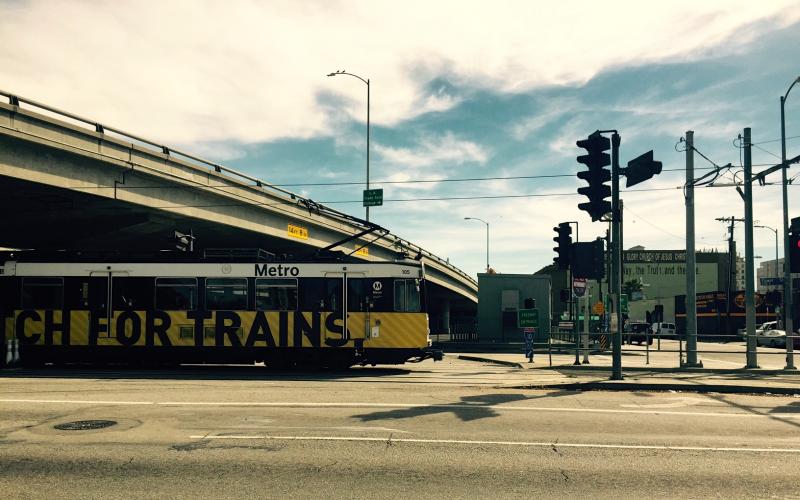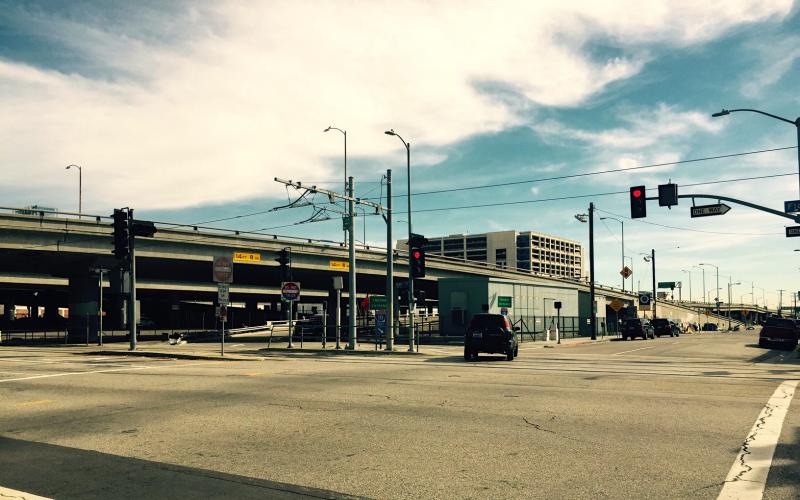Intersection Holds Highest Number Of Blue Line Accidents

Jacki Luquin has an unwanted front row seat from her spot behind the desk of RPM Lenders Car Title Loan and Auto Pawn. She’s been at this location for about three years and has seen as many accidents involving vehicles and trains on the Metro Blue Line, which connects Long Beach and downtown Los Angeles.
“The one that happened right here,” Luquin said, pointing to the intersection of 18th St. and the Blue Line, that runs with Flower St. “The car was smashed like a taco, but the person who was driving, she was actually OK. I was surprised. But it was pretty bad.”
The intersection outside of Luquin’s work window has the highest number of accidents involving trains on the Metro Blue Line and vehicles on its path, an analysis of Los Angeles County Metro Transportation Authority data shows.
The train intersection at nearby Venice Boulevard reported the second highest number of accidents on the line, with 13 vehicular accidents during that time period. During an 11-year period ending in September 2014, 16 vehicles and one pedestrian were in accidents involving trains on the blue line, according to the Metro report.
Both of the intersections are located downtown, share a stretch with the Expo line and move above ground with traffic.
While Metro has designed large banners for the sides of trains that read “Heads Up! Watch For Trains” and installed various signs and lights, the safety measures sometimes cannot compete for drivers’ attention.
At the 18th St. intersection, parking lot attendants usher in visitors to nearby Staples Center and L.A. Live and vehicles enter the ramp to the 10 Freeway.
SEE ALSO: Expo Line Train Hits Car Near USC, Injures 21
Leaving from the 7th Street Metro Center, the Pico St. Station is the last stop before the danger zones of Venice Blvd. and 18th St. Metro Safety Ambassador Fredrick Williams has witnessed numerous accidents from his post at the Pico St. Station, but he said they are mainly at 18th St.
“A motorist made a turn in front of the train there, which couldn’t help but have an accident,” Williams said. “There are many signals there. There are signs there for people to as motorists pay attention to. Sometimes, for whatever reason, they get ignored. If those signals are ignored, and the train is approaching, than an accident can and will happen.”

“The freeway is there, you have that left turn lane there and so I don’t know if it’s a combination of those two things the freeway, the left hand lane and then the train, the freeway being extra traffic-congested, the train passing through as a vehicle that can’t always stop on a dime,” Williams said.
Luquin witnesses the repercussions of drivers who didn’t notice the Metro while trying to enter the on-ramp.
“When they are going into the freeway, a lot of people are not paying attention to the signal. so they’ll go ahead and turn left and then the Metro is coming, and it will basically just drag them down,” Luquin said.
The Los Angeles Times recently reported that trains on the Blue Line were responsible for running approximately 55 red lights in a two year period ending in 2014.
In 2012, a collision with a Metro bus resulted in injuries for over 30 people at the intersection of San Pedro St. and Washington Blvd.
Luquin thinks the design of the intersection compounded with the distraction of the parking lot is to blame for the accidents.
SEE ALSO: USC Student In Metro Crash Identified
“I don’t think it has to do with the Metro, I think it has to do with the people not paying attention,” said Luquin. “The signals are there. It could be confusing for them too, especially if they’re not from this area.”
She recalls an accident where a man’s car ended up under the Metro because he was from out of town and trying to park his car in the parking lot under the freeway.
“There’s a parking lot right down there where they are flagging cars down to go into the parking lot and the customers are not paying attention to the Metro. They are paying attention to the flag going into the parking lot.”

Her Market is located in the second most accident-prone area of the Blue Line. She’s had accidents outside her door.
“I saw when the train hit the horn right after the freeway,” Estrada said. “He was stopping the traffic for a Lakers game.”
She remembers it being dark already. The train hit the horn again but the car didn’t hear it. The train slowed down, coasted and hit the car containing a young couple.
“I don’t think they heard the train because their windows were closed, and there was a lot of traffic,” Estrada said. “I jumped and ran to the back. I thought the car was going to run into the store but it didn’t.”
After hiding in the back with her dog, Estrada learned the couple was not fatally injured, but the car was destroyed. Estrada’s business remained intact.
SEE ALSO: 7 Innovations To Make L.A. Metro Better
“We’ve seen a couple of cars going into the parking and they don’t pay attention. The train is coming, the train blows a horn and they don’t pay attention. They’ve gotten hit, but nothing bad,” she said.
She says people who are involved in car accidents at her location have usually survived. In fact, according to the Metro report, no fatalities occurred in accidents at Venice Boulevard. and the Blue Line.
Only one fatality has occurred at the 18th St. intersection. In November 2008 a pedestrian or bicyclist entered the trackway and was hit by a train. According to the report, the incident was not coded as a suicide.
Estrada thinks the responses of Metro train drivers has lessened the impact of the car accidents.
“Usually here the train is able to at least slow down,” she said. “It has been not a full impact of the full body of the car because of that.”

“If you’re an operator you have to be, as they say, getting the big picture,” Williams said. “You have to be paying attention to everything that is around you.”
Williams had three accidents in his bus driving career. All of them involved cars. He never hit a pedestrian.
“You never want to be in an accident. You never want to hurt anyone. I was always a safety-first kind of person anyway, but there are things out there you just have to pay attention to as an operator,” Williams said. “You have to understand that anything can happen at any time of day or night whatever the weather conditions are.”
Today Williams is a presence to ensure safety on and around the Pico St. platform. In cases where a vehicle and train collide, he contacts the radio dispatcher to get the accident response team to the scene. He then assists in a variety of tasks depending on the situation: crowd control, calling an ambulance.
Last year he witnessed an accident from his spot at the Pico St. station, where the driver of a Mini Cooper was texting and didn’t sense the train coming.
“She went away in an ambulance, but she didn’t seem like she was hurt very bad,” he said.
He’s not sure what happened to the woman. He never heard anything else about it. He’s just there, ready for the moment.
Reach Staff Reporters Hillary Jackson and Daniel Jimenez here and here.



